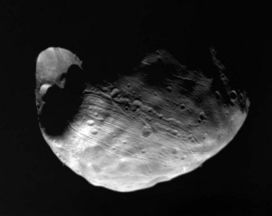
![]() Main Page
Main Page
![]() Feedback
Feedback
 The Author
The Author
 News
News
 Search
Search
 The Planets
The Planets
 Mercury
Mercury
 Venus
Venus
 Earth
Earth
 Mars
Mars
 Jupiter
Jupiter
 Saturn
Saturn
 Uranus
Uranus
 Neptune
Neptune
 Pluto
Pluto
 Dwarf Planets
Dwarf Planets
 The Solar System
The Solar System
 The Sun
The Sun
 The Moon
The Moon
 Meteors
Meteors
 Comets
Comets
 Asteroids
Asteroids
 Amazing facts
Amazing facts
 Other
Resources
Other
Resources
 Poster Store
Poster Store
 Multimedia
Multimedia
 Links
Links
 Awards
Awards
 Glossary
Glossary
 Astronomers
Astronomers
 Webrings
Webrings
 Bibliography
Bibliography

Technical Data:-
| Diameter | 22.2 km(Phobos) 12.6 km(Deimos) |
| Average Distance from Mars | 9,378 km(Phobos) 23,459 km(Deimos) |
| Max surface Temperature | -4C(Phobos) |
| Min surface Temperature | -112C(Phobos) |
| Length of Day | 1.026 days(Phobos) 1.026 days(Deimos) |
| Length of Year | 0.3191(Phobos) 1.26244(Deimos) |
| Eccentricity of Orbit | 0.015(Phobos) 0.0005(Deimos) |
| Density | 2 gm/cm3(Phobos) 1.7 gm/cm3(Deimos) |
| Atmosphere | n/a |
More pictures of Deimos and Phobos Here |
|
Phobos, Mars' closest satellite, is named after the Greek word meaning 'fear', whilst Deimos means 'terror', both following on from the Mars/War theme. Orbiting at a meagre 6000km from the surface of Mars, Phobos is the closest moon to its parent planet in the Solar System (at least that we know of), whilst Deimos is the smallest known planetary moon in the Solar System. Phobos and Deimos are both believed to be captured asteroids, due to their irregular shape and small size (Phobos having a 22.2km wide diameter, whilst Deimos is only 12.6km wide!). Both moons are heavily cratered and are believed to be made up of rock and ice. Like our moon they have a coating of dust on their surfaces. Phobos' orbit is such that it rises in the west and sets in the east, often more than once in one day. However, I'm afraid there doesn't really appear to be much of a future left for Phobos as an independant moon of Mars. This is because in little over 50 million years it is destined to crash into Mars (with a thud) due to the planet's tidal forces lowering its orbit (presently at about 1.8cm/year). Nevertheless, it (and Deimos) have been seen by many spacecraft since it was discovered by Asaph Hall in 1877, such as the Mariner 9, Viking 1, Phobos and Phobos 2, the last of which even detected an outgassing coming from Phobos. |
|